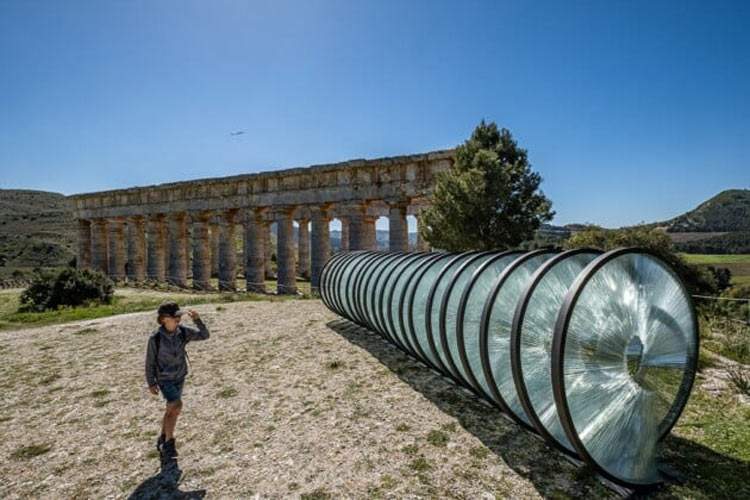What has happened in Sicily, at the Segesta Archaeological Park, in recent days is sensational. On April 13, in fact, an exhibition of contemporary art, In Nature with the Mind, opened in the park’s spaces, including four installations for a project curated by Agata Polizzi and Beatrice Merz of the Merz Foundation. They are all works by important artists: a neon installation by Mario Merz(Fibonacci Sequence from 2002), another light work by Merz(A Sign in Caesar’s Hole from 2003, originally made for the Imperial Forum and for the occasion placed in the Agora of Segesta), a glass sculpture by the Greek Costas Varotsos(The Spiral, perhaps the most photographed work in the exhibition), and an intervention by Ignazio Mortellaro in the Antiquarium.
“In the same months in which the region is promoting the resumption of countless archaeological missions,” Cultural Heritage and Sicilian Identity Councillor Alberto Samonà said in the days leading up to the opening, “new codes of interpretation are being sought, as in this case. It is an initiative that stems from the idea that our temples, the places of archaeology, are not just the preserve of scholars and tourists, but are above all open spaces for reflection and listening.”
After a week, however, came the screeches of Vittorio Sgarbi, who, in a Facebook post with a photo of Varotsos’s work, spoke out against the initiative: “I wonder why,” the art historian wondered, “violate the sacredness of places so full of poetry and beauty with these monstrosities.”
The reaction of the regional president, Nello Musumeci, was not long in coming: the Sicilian governor espoused Sgarbi’s thinking and disavowed his councillor, stating that “the secular sacredness of our archaeological parks does not allow contamination by other cultural initiatives, however dictated by good intentions.” Musumeci went on to say that he had asked Samonà “to issue an act of direction so that the directors of the Parks stick to homogeneous evaluations. Meanwhile, the artistic display currently housed in Segesta should be moved to another location.”
The measure, the Ansa reports, has already been signed by the councilor: however, it is not a definitive stop to contemporary art in archaeological parks as Musumeci’s peremptory tones might suggest. The measure is aimed, Samonà explained, “at ensuring that every single contemporary art installation to be carried out in archaeological areas and parks is preceded by the presentation, by the proposing party, of a detailed exhibition project to be submitted to the preliminary departmental authorization.” The councilor says he is not opposed to installations such as those at Segesta, however, he concludes, “he believes that they should always be complementary to the context in which they are implanted and must facilitate the creation of a harmonious relationship between ancient and contemporary, which enhances the archaeological context, which in no case should be altered or be harmed by the contemporary installation.”
For the moment, no statement on the Segesta project itself, which even Samonà himself had praised at the opening. In any case, in Sicily the situation of cultural heritage is particularly complex and very different from the rest of Italy (Sicily enjoys a specific autonomy in the sector): in fact, an operation of centralization of decision-making is underway, which on these pages has been the subject of several in-depth studies by Silvia Mazza, as well as the problem of the diminishing autonomy of technicians at the expense of politics, which in the island can even enter the technical-scientific committees of archaeological parks. The case of Segesta seems a further step in this direction.
Pictured, The spiral of Costas Varotsos at Segesta.
 |
| Sicily, case breaks out: installation not liked and president wants it removed |
Warning: the translation into English of the original Italian article was created using automatic tools. We undertake to review all articles, but we do not guarantee the total absence of inaccuracies in the translation due to the program. You can find the original by clicking on the ITA button. If you find any mistake,please contact us.